Mid-early potato variety “Krasavchik” with amazing taste
The Handsome potato received its name for the visual attractiveness of the tubers. The bright red peel attracts the attention of buyers and vegetable growers. This variety is able to quickly adapt to any climate and different soil composition. It retains its marketable appearance for a long time, so it is often grown in large volumes. But the main advantage of Handsome is the high resistance of tubers to mechanical damage.
Description of the variety
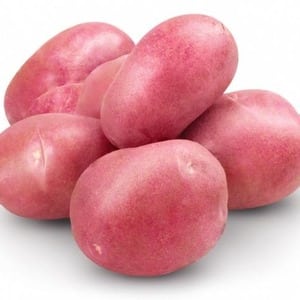
Potatoes Krasavchik – table, mid-early variety. The bush is semi-erect, medium height, moderate spreading. The leaves are dark green, slightly wavy along the edges. The plant blooms with white flowers with a pale blue tint.
The variety is able to grow in soil with any composition, is well adapted to hot weather, and is drought-resistant.
Origin and development
The varietal crop was obtained as a result of the work of specialists from the Research Institute of Potato Farming named after A. G. Lorch. Included in the State Register of Breeding Achievements in 2009.
Numerous tests have confirmed the crop's productivity and high resistance to damage. The ability of the plant to fully develop in any soil composition was also noted.
Reference. Alexander Georgievich Lorkh is a Soviet breeder of the 19th century who laid the foundation for potato variety testing in the USSR.
Chemical composition, trace elements, vitamins
Handsome has a high starch content - 18%. Macroelements include calcium, magnesium, sodium and phosphorus. The chemical composition is complemented by microelements such as iron, zinc, iodine, copper and selenium.
Nutritional value is determined by the content of proteins and carbohydrates. Per 100 g of product there are 2 g of proteins and 16 g of carbohydrates; the vegetable does not contain fats. Calorie content – 77 kcal.
The biological value of potatoes lies in their vitamin composition. Tubers contain vitamin C (200 g of the product meets the body’s daily requirement), a full complex of vitamins B, vitamin A and vitamin E.
Among the mineral salts, the tubers contain potassium salts, and among the organic acids, oxalic and citric acids are noted.
Ripening time and yield
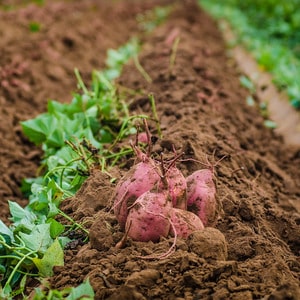
The ripening period is mid-early: 80-90 days pass from the moment of emergence to full ripeness.
The characteristics of the variety are complemented by productivity indicators. From 170 to 200 centners are collected from 1 hectare. The maximum rate was recorded at 280 c/ha. One bush produces 6-10 tubers with a total weight of up to 5 kg.
The yield of marketable products is 85-97%. Keeping quality is high - no less than 97% of the total volume.
Disease resistance
The plant is endowed with increased immunity to potato canker, wrinkled mosaic virus and tuber late blight. Resistance to leaf blight is average. The golden nematode poses a serious threat.
Characteristics of tubers, appearance
Average weight – 90-150 g, oval or oval-round shape. The color of the peel is red, the flesh is light cream in color, the taste is at a high level. Potatoes are universally used - they are suitable for making semi-finished products, chips and fries. In the household it is used for cooking, frying, stewing and baking.Potatoes can withstand any heat treatment, do not crack and retain the whiteness of the flesh.
Ripe vegetables can withstand transportation over any distance without losing their presentation.
The photographs show the Handsome potato.
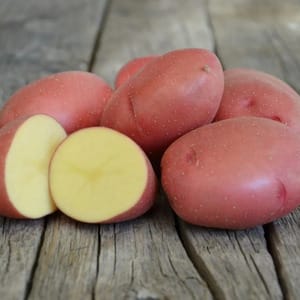
What regions is it suitable for?
Potato Krasavchik is recommended for cultivation in the Central Black Earth region. The variety also shows high productivity in the Republic of Moldova and Ukraine. Potatoes, well adapted to hot climates, take root well in the southern regions.
Advantages and disadvantages
Numerous advantages distinguish Handsome from other varieties:
- grows in any soil;
- high-yielding;
- stable immunity to many diseases;
- simple agricultural technology;
- drought resistance;
- excellent taste;
- universal application;
- long-term storage;
- long transportations.
Among the disadvantages, instability to the golden nematode is noted.
Difference from other varieties
The main difference is increased resistance to mechanical damage. The tubers remain smooth and beautiful regardless of external influences. This factor determined the name of the culture. Vegetable growers also note rapid adaptation and full development even in heavy soil.
Planting and growing
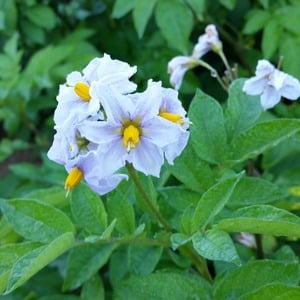
The plant is considered unpretentious in care, but without proper preparation of the seed material, you can lose part of the harvest.
Pre-sowing preparation
Tubers to landing prepared a month in advance. During this time they need to be germinated and greened. The weight of planting tubers should not exceed 100 g.
After careful inspection, the seed material is laid out in a bright room at a temperature of +15...+17°C. Lower temperatures lead to the formation of brittle sprouts.
Reference. Before germination begins, those sprouts that formed during storage are removed.
Immediately before planting, the seed is treated with a growth stimulant and Fitosporin, which protects against fungal spores. Stimulants used include Epin or Kornevin.
Soil requirements
For planting Krasavchik potatoes, it is best to choose open sunny areas - they are thermophilic.
Soil acidity should not exceed 5.5 units. If the indicator is elevated, the soil is deoxidized using dolomite flour or slaked lime. Litmus paper will help determine acidity. Dissolve a little earth in a glass of water and place an indicator. Red color means high acidity.
Reference. Plants on the site will help determine acidity. The appearance of sorrel, blueberries or lupine indicates an acidic environment.
To increase the fertility of the soil, it is dug up twice with the addition of ash and humus. The first digging is carried out in the fall, after harvesting, the second time in the spring, before sowing.
Dates, scheme and rules of planting
Optimal time for planting potatoes: late April - early May. The main factors to focus on are air and soil temperature. Tubers are planted as soon as the soil warms up to +9...+11°C, and the soil temperature stabilizes at +16...+19°C. In cold regions, this temperature regime is reached no earlier than the end of May.
The seed is planted at a distance of 30 cm from each other. The width of the rows is at least 60 cm. The depth of the holes is 8-10 cm. Before sowing, no more than 50 g of wood ash is placed at the bottom of each hole.
Features of cultivation
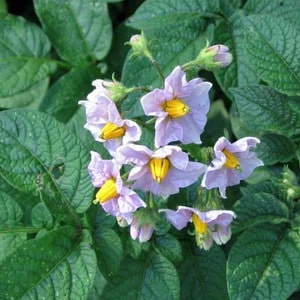
Crop care is based on conventional agricultural practices: watering, fertilizing, loosening, weeding and hilling.
Watering mode
Watering begins after the bushes grow to 10-15 cm. A large amount of moisture is needed only during flowering, when the formation of tubers begins. For each seedling, at least 4-6 liters of water are consumed; in severe drought, the volume is increased to 10-12 liters.
Lack of moisture during tuber formation leads to a decrease in their size.
Feeding
Fertilizing begins when the seedlings are 15-20 cm high. For the first feeding, use organic matter - bird droppings or mullein infusion in a ratio of 1:10. For each seedling, 2 liters are consumed.
During flowering, the crop is fertilized with a complete mineral complex, focused on phosphorus.
During fruiting, potassium is added in combination with nitrogen.
Reference. All fertilizing is carried out on abundantly moist soil. Timely application of fertilizers significantly increases productivity.
Loosening and hilling
Loosening improves oxygen access to the roots, which is necessary for seedlings to fully develop. Loosen the beds after watering. Then they are weeded and mulched. Mulch, such as straw or peat, prevents new weeds from growing and retains moisture.
Hilling is carried out on damp soil - after watering or rain. The bushes are earthed for the first time when they are 20-25 cm tall. The ridge is made no lower than 10 cm. Hilling protects the tubers from sunlight and pests. The second time, the ridge is raised to 20 cm. The seedlings are hilled on both sides, without filling the center.
Disease and pest control
Potato diseases are rare, but the variety is defenseless against the golden nematode. These are small pest worms, from whose vital activity the foliage dries out and flowering does not occur.To avoid their appearance, it is necessary to dig up the soil twice - during digging, adult individuals and their larvae are destroyed.
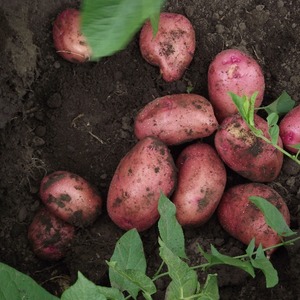 In order to prevent nematodes, planting tubers are treated with the preparation “Gumi” or “Albit”, and the area before sowing is treated with urea at the rate of 1 kg per 10 square meters. m. Also, the golden nematode is afraid of the smell of certain plants - marigolds, sweet clover and calendula.
In order to prevent nematodes, planting tubers are treated with the preparation “Gumi” or “Albit”, and the area before sowing is treated with urea at the rate of 1 kg per 10 square meters. m. Also, the golden nematode is afraid of the smell of certain plants - marigolds, sweet clover and calendula.
The mole cricket and the Colorado potato beetle are especially dangerous for potatoes. Preventive measures in the fight against mole crickets are carried out in advance. Almost immediately after planting the tubers, Medvetox granules or crushed garlic cloves are buried in the ground. The smell repels the pest, and it does not approach such beds.
A thorough inspection of the seedlings helps to notice the Colorado potato beetle in time. The Colorado potato beetle is dangerous because it destroys crops in a short period of time. To combat it, appropriate insecticides are used, for example, “Prestige”.
Difficulties encountered during cultivation
Subject to the rules of crop rotation, soil fertility and plant health are maintained. In addition, compliance with established standards increases crop productivity.
Potatoes are planted in beds where carrots, onions, cabbage, legumes and winter crops previously grew. Potatoes are not planted after crops from the nightshade family, as these plants greatly deplete the soil.
If you plant marigolds between potato seedlings, you can scare away nematodes and whiteflies from the beds. In the fall, the soil is dug up along with these flowers, and worms will not appear in the ground.
Harvest and storage
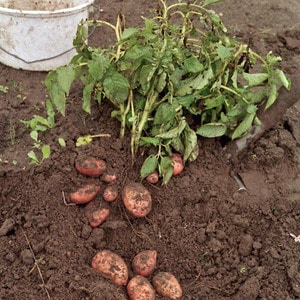
Harvesting begins in August. Tubers that have reached technical maturity are practically not subject to damage.They are dug out of the ground with a pitchfork or shovel and left on the site to dry. In cloudy weather, the crop is harvested under a canopy so that the tubers are not wetted by rain.
Drying takes 2-3 days, after which the crop is ready for long-term storage.
Keeping quality of the variety, storage conditions
The variety has an increased shelf life; regardless of the length of time, the presentation is preserved in 97%. The room in which the harvested crop is left must be dry, well ventilated and dark.
Vegetables are stored in wooden boxes. They are transported in the same boxes.
Tips and reviews from gardeners
Tips from vegetable growers regarding harvesting:
- Carry out cleaning in clear and dry weather. During rains, the likelihood of tubers being damaged by wireworms increases.
- Three weeks before harvest, dig in the potato foliage. The stems will dry out, and all the starch will go into the tubers.
The culture receives positive reviews quite deservedly. Gardeners willingly share them.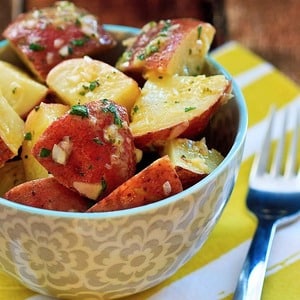
Olga, Kostroma: «I planted 20 kg of Krasavchik potatoes last year, the harvest was good. I collected 2.5-3 kg from the bushes, the tubers themselves weighed on average 100 g. I didn’t particularly fertilize the seedlings. The potatoes have a pleasant taste, I liked it. A special plus for me personally is that the tubers do not boil over. I will definitely plant more.”
Anton, Tambov: “I recognized the Potato Krasavchik from the description of the variety and a photo from the Internet. I've been growing it for 2 years. Everything is fine, I am reaping large harvests. The tubers are smooth, beautiful, and always sell well. Care: I regularly carry out preventive treatments and feed with Nitrophoska. I'll definitely keep it for the winter. Vegetables are perfectly preserved until spring, without losing their taste or appearance.”
Read also:
Potatoes in the fight against hemorrhoids: how to make suppositories and compresses for treatment.
Description and characteristics of the Laperla potato variety.
Conclusion
The Handsome potato takes root not only in the south, but also in regions with cool climates. The variety practically does not get sick throughout the entire growing season and shows high yield in soil with any composition. The application of fertilizing significantly increases the quantitative indicator - up to 250 c/ha. The taste qualities are high, which allows you to grow the crop both for personal use and for sale.